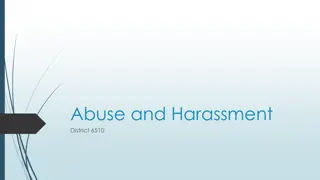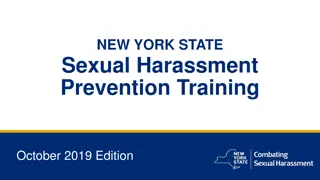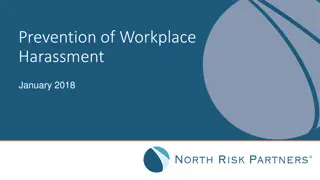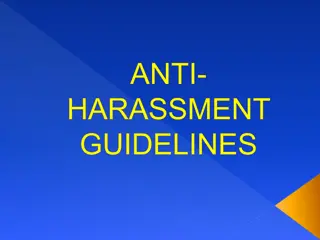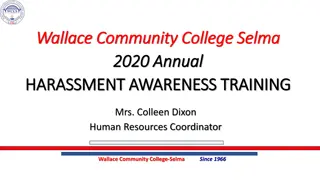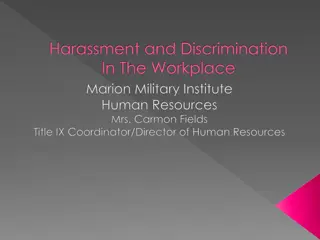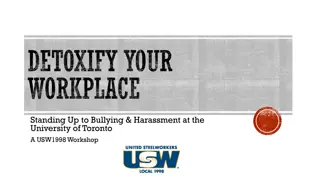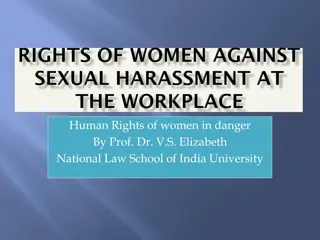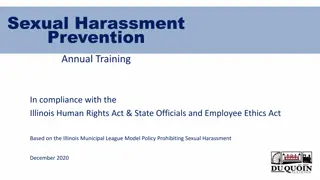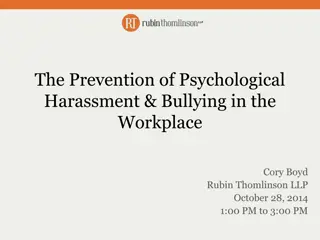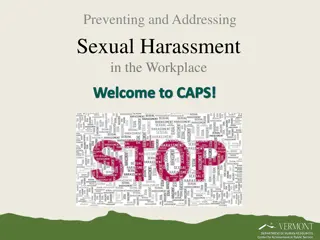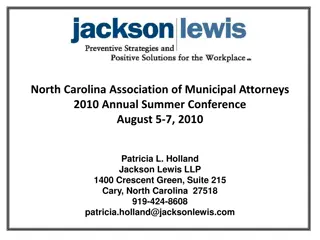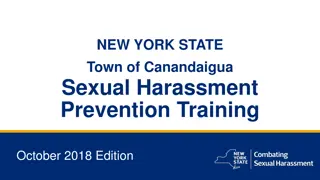Understanding Workplace Harassment and Prevention
Workplace harassment, a form of employment discrimination, violates various laws and creates hostile work environments. It includes unwelcome conduct based on protected characteristics and can be classified into different types such as sexual harassment, quid pro quo harassment, hostile work environment, bullying, and third-party harassment. Prevention and elimination of harassment are crucial responsibilities for all individuals in the workplace to maintain a respectful and safe environment.
Download Presentation

Please find below an Image/Link to download the presentation.
The content on the website is provided AS IS for your information and personal use only. It may not be sold, licensed, or shared on other websites without obtaining consent from the author. Download presentation by click this link. If you encounter any issues during the download, it is possible that the publisher has removed the file from their server.
E N D
Presentation Transcript
Preventing Workplace Harassment Bureau of Workers Compensation PA Training for Health & Safety (PATHS) PPT-086-01 1
Objectives Define harassment. For every employee to KNOW they have a right to work in a respectful environment. Know the different types of harassment. Understand what to do when harassment occurs. Supervisor s responsibilities. Protecting yourself. PPT-086-01 2
Harassment Harassment is a form of employment discrimination that violates Title VII of the Civil Rights Act of 1964, the Age Discrimination in Employment Act of 1967, (ADEA), and the Americans with Disabilities Act of 1990, (ADA). PPT-086-01 3
Harassment Harassment is unwelcome conduct based on race, color, religion, sex (including pregnancy), national origin, age (40 or older), disability or genetic information. Harassment becomes unlawful where: 1) Enduring the offensive conduct becomes a condition of continued employment, or 2) The conduct is severe or pervasive enough to create a work environment that a reasonable person would consider intimidating, hostile, or abusive. PPT-086-01 4
Harassment A hostile work environment serves no good purpose. The prevention/elimination of harassment is EVERYONE S responsibility. Don t become the next news story. Or worse The next court case . PPT-086-01 5
Types of harassment Sexual Harassment Quid Pro Quo Harassment Hostile Work Environment Bullying in the Workplace Third-party Harassment PPT-086-01 6
Sexual Harassment Sexual Harassment is: Unwelcome, unwanted, or offensive sexual advances, requests for sexual favors, and other verbal or physical conduct of a sexual nature when: 1. Submission to the conduct is made either explicitly or implicitly a term or condition of the individual s employment; The conduct is unwelcome, unwanted, or offensive and has the purpose or effect of unreasonably interfering with an individual s work performance, or creating an intimidating, hostile or offensive working environment. 2. QUID PRO QUO (something given in exchange for something else) PPT-086-01 7
Quid Pro Quo Harassment Examples of Quid Pro Quo harassment include: A supervisor telling a subordinate employee that if he/she accompanies the supervisor for a weekend get-away, the supervisor might be able to arrange for some paid time off for the employee, or look into a promotion for the employee. A person in authority threatening to discredit a subordinate employee if they won t attend a party with them after work. PPT-086-01 8
Hostile Work Environment A hostile work environment is created by a boss or coworker whose actions, communication, or behavior make doing your job impossible. This means that the behavior altered the terms, conditions, and/or reasonable expectations of a comfortable work environment for employees. Additionally, the behavior, actions or communication must be discriminatory in nature. PPT-086-01 9
Hostile Work Environment Examples of Hostile Work Environment: Degrading Comments Sexual Propositions Vulgar Language Sexual Touching Embarrassing Questions Sexual Jokes Bullying PPT-086-01 10
Bullying in the Workplace What is a Bully? A blustering browbeating person; especially: one habitually cruel to others who are weaker.* Potential Concerns Discrimination/harassment claims Workplace violence Drain on morale Increased turnover Low productivity Impact on bottom line Source: * Merriam-Webster.com PPT-086-01 11
Bullying in the Workplace 35% of Workers Feel Bullied at Work (Up from 27% in 2011) 16% Suffered Health Problems as a Result 17% Quit Their Jobs to Escape the Bullying Most Complaints Are About Being Bullied by a Supervisor or Coworker (Also against customers) Source: CareerBuilder.com survey PPT-086-01 12
Bullying in the Workplace Most bullying is same-sex harassing behavior often not covered by laws and employer policies Women = 58% of the Perpetrator Pool Half of all reported bullying is woman-on-woman: status-blind harassment Bullying is psychological violence often misclassified as personality clashes 3x more prevalent than sexual harassment PPT-086-01 13
Third-Party Harassment Behavior not found offensive by some employees can facilitate an offensive environment for other employees. Example: A group of employees talking about each other s sex lives in the presence of another person who feels very uncomfortable about such discussions. PPT-086-01 14
What to do Any employee believing they have been subjected to discrimination, workplace harassment or sexual harassment should report that behavior to their immediate supervisor, another member of management or the agency Human Resource section. A complaint may be made verbally or in writing. PPT-086-01 15
What to do Why is it important for employees to report discrimination, workplace harassment and sexual harassment? Discrimination, workplace harassment and sexual harassment can cause: Employees to be hurt emotionally Productivity to go down Absenteeism to go up The work of the agency to be jeopardized Employees to be fearful of others Workplace morale to be reduced PPT-086-01 16
What to do Why do employee s hesitate to report discrimination, workplace harassment and sexual harassment? Fear of losing their job Fear of retaliation Fear of getting someone into trouble Fear of disrupting the workplace Fear of being embarrassed Fear of not being believed. PPT-086-01 17
What to do Be assertive Check with others Keep a diary Use performance documents / reviews Seek appropriate counseling PPT-086-01 18
What to do If harassment continues, tell someone File a complaint Seek a new job File civil or criminal charges Consider writing a letter PPT-086-01 19
Supervisor Set an example of respectful workplace behavior. Have clear expectations that discrimination, workplace harassment and sexual harassment are not tolerated. Have a clear mechanism for reporting; including the ability to report to another member of management should the supervisor be the accused. Take immediate steps to stop inappropriate behavior or conduct as it occurs or is reported. PPT-086-01 20
Supervisor Guard against retaliation. Handle investigations as discretely and confidentially as possible. Be sensitive to the feelings of all involved. It is not easy for the complainant, the accused or anyone participating in an investigation. PPT-086-01 21
Supervisors Guidelines Know the policy on Sexual Harassment. Keep employees informed of the policy. Communicate the complaint procedures. PPT-086-01 22
Supervisors Guidelines Keep lines of communication open. Act immediately if you suspect harassment. Accurately document suspected incidents. PPT-086-01 23
Supervisors Guidelines Report concerns/complaints to the appropriate department. Listen seriously to all harassment complaints. Encourage employees to say NO to harassing behavior. Keep everything confidential. PPT-086-01 24
Protecting Yourself Keep your hands to yourself. Don t talk about sex on the job. Never mix social life with job related discussions. Keep any compliments casual and fairly impersonal. PPT-086-01 25
Protecting Yourself Avoid jokes, words, phrases and gestures with sexual meaning. Respect a person s personal space . Do not respond to seductive behavior. Respectful behavior facilitates more productive employees. PPT-086-01 26
Protecting Yourself Together we must work to create and maintain a work environment that is free of workplace harassment. PPT-086-01 27
Policy Assistance A toolkit produced by XpertHR in partnership with LexisNexis includes an example of how the policy might begin. Other policies might also be found on the Internet due to the magnitude of this problem. Search available sources and produce a Policy for your facility to eliminate the threat and protect yourself from liability. PPT-086-01 28
Contact Information To contact a Health & Safety Training Specialist: Bureau of Workers Compensation 1171 South Cameron Street Room 324 Harrisburg, PA 17104-2501 717-772-1635 RA-LI-BWC-Safety@pa.gov Like us on Facebook! - https://www.facebook.com/BWCPATHS PPT-086-01 29
Questions PPT-086-01 30






